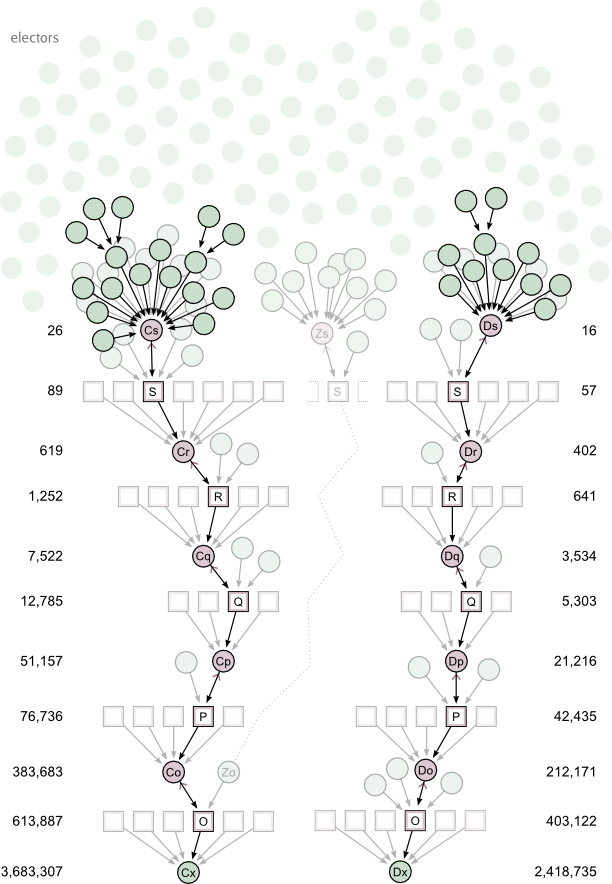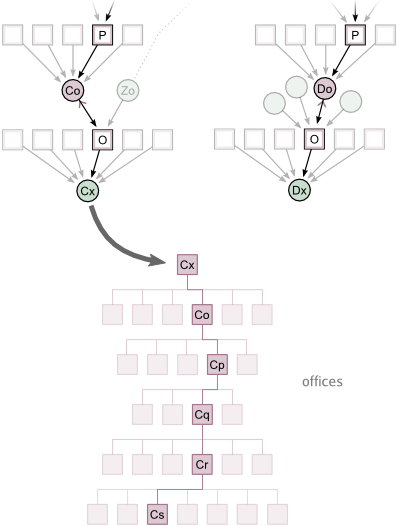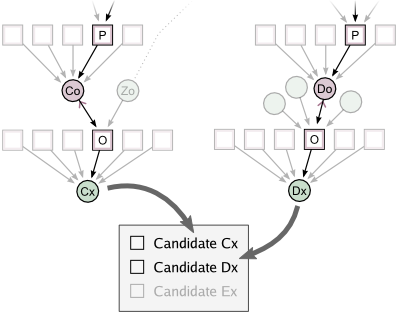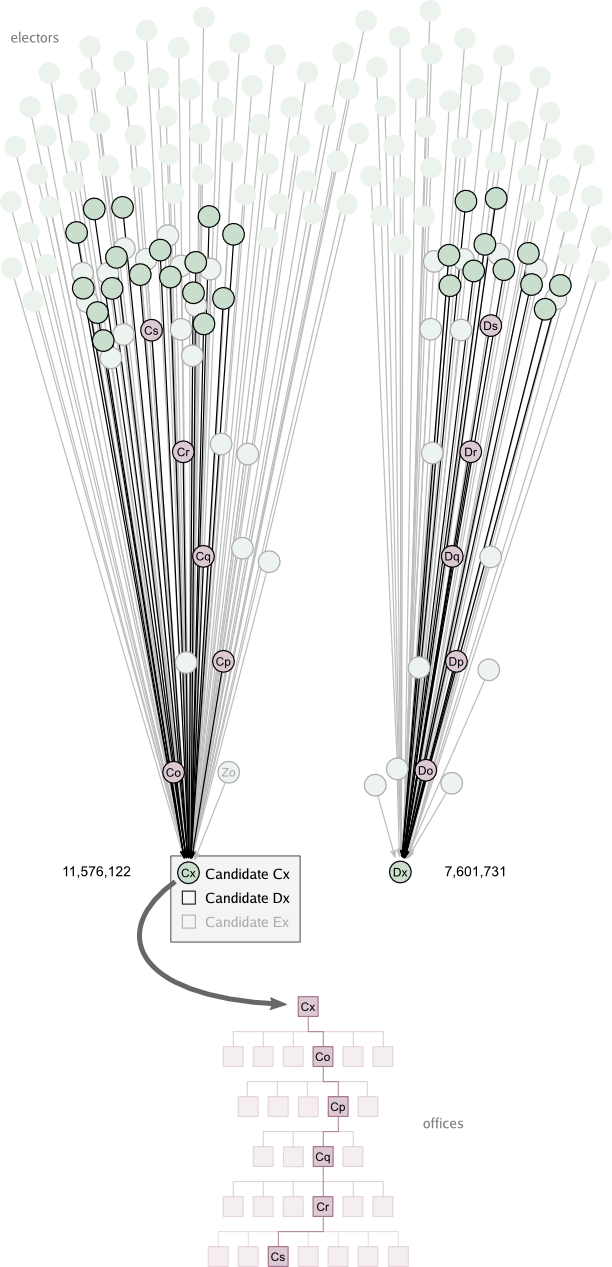Guidance of executive power structuring is the coordinated staffing of executive and managerial offices.
1 The coordination begins with a continuous, open primary to nominate the officers, including the chief executive and appointees at all levels. A candidate applies for a given office by voting for an office pipe, and by constructing pipes for any immediate sub-offices. See figure ON. Candidate Eo is applying for office O. She has constructed pipes for sub-offices R, S and T, through which she receives the votes of sub-applicants.
 |
[ON] Office nomination before and after. Three candidates (Co, Do and Eo) are applying for office O under super-candidate Ca. The numbers at each node register the quantity of primary votes received in thousands. Eo leads with 30,000 votes and is awarded the nomination (right). legend
The super-candidate of an office may nominate any candidate at any time. He does this by setting the candidate's name on the pipe. Likewise he may withdraw the nomination, leaving the office without a nominee. The purpose of nomination is to signal the intent to appoint a particular candidate. The super-candidate is under no obligation to nominate the candidate who carries the most votes. By the same token, the electors and candidates are free to shift their votes at any time, or to withdraw them. They may signal their support for a particular candidate by voting into that candidate's branch or tree, as shown in figure SN. The typical elector is usually positioned among the leaves (top) because he/she votes for a candidate who is personally known, familiar, or otherwise worthy of trust. This usually means a junior candidate such as Cs, Zs or Ds. Each vote nevertheless flows rootward, lending its support to intermediate and senior candidates en passant, and thus to a complete chain of command (Cs, Cr, Cq, Cp, Co, Cx). Collectively the votes cascade together and pool at the root, where the total serves to nominate the entire power structure for office.2
 |
[SN] Structural nomination. Two rival power structures in a primary contest for nomination. The view is restricted to a single chain of command extending from the root office (chief executive) through sub-offices O to S, and further restricted to the branch of the nominated candidates (magenta). Many other branches also extend to the leaves (as from Zo to Zs), making the trees far bushier than shown. Root candidate Cx leads with 3,683,307 votes. legend
In a parliamentary system
In a parliamentary system, the executive primary is run by a network of open parties. Each takes for its titular leader the root candidate who currently leads in the primary. Given the results in figure SN, for example, candidate Cx is the leader of all open parties. She maintains that title for as long as she maintains her lead in the primary.3 As a consequence, if the open parties do well enough in the next parliamentary elections, then the head of state will invite Cx to form the next government.4 She may then enter into office and appoint the subordinates whom she had previously nominated. These may in turn appoint their own subordinates, and so forth, until the entire structure nominated by the electors is in power.
 |
[IA] Invitation and appointments. The open parties having done well in the parliamentary elections, the head of state invites their titular leader (Cx of figure SN), to form the next government. She enters office and appoints the subordinates whom she had previously nominated, such as Co. These in turn appoint their own subordinates, and so forth, until the entire structure is in power. The view above is restricted to match the nomination view of figure SN, and therefore shows only a small portion of the overall structure. legend
In a presidential system
 |
[B] Ballot. The leading nominees in the open executive primary (Cx and Dx) place themselves on the ballot for the upcoming presidential election (next figure). A third candidate (Ex) is placed by a closed party nomination (not shown). legend
In a presidential system, the leading nominees in the open executive primary place themselves on the ballot for the upcoming presidential election (figure above). Should one of them win, she enters office and appoints the subordinates whom she had previously nominated (figure below). Again, these in turn appoint their own subordinates, and so forth, until the entire structure nominated by the electors is in power.
 |
[EA] Election and appointments. A partial view of a presidential election and its ensuing appointments. The view is restricted to match the nomination view in figure SN. Cx wins with 11,576,122 votes. She enters office and appoints the subordinates whom she had previously nominated, such as Co. These in turn appoint their own subordinates, and so forth, until the entire structure is in power (much larger than shown). legend
Property settings
Notes
- ^ See Stuff:Broad-based decision guidance.
- ^ It has been proposed that office pipes might also be used to nominate committees, as shown in figure CN.
 |
[CN] Committee nomination. Of thirteen applicants for committee O, five (B, C, D, F, G) are nominated by the pipe minder (not shown).legend
- ^ Care should be taken in extracting a decision such as this from the continuous primary. See the discussion here for a possible solution: http://lists.electorama.com/pipermail/election-methods-electorama.com/2013-March/031647.html.
- ^ The titular leader of an open party has no role other than to accept, on behalf of the party, an invitation from the head of state to form a new government. She (or he) has no authority within the party.
- ^ Namely the chief officer.
- ^ Namely the direct and indirect appointments of the chief officer.
- ^ The guiding consensus and lines of communication are formed within the executive primary as described here.
- ^ Guidance from the primary enters the electoral system and executive offices across the system gap as described here.





